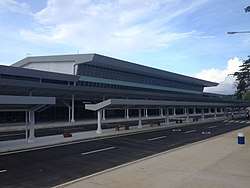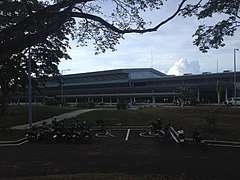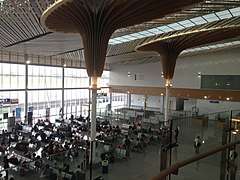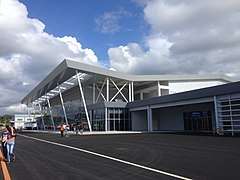Puerto Princesa International Airport
| Puerto Princesa International Airport Paliparang Pandaigdig ng Puerto Princesa | |||||||||||
|---|---|---|---|---|---|---|---|---|---|---|---|
 The New Puerto Princesa International Airport | |||||||||||
| Summary | |||||||||||
| Airport type | Public | ||||||||||
| Operator | Civil Aviation Authority of the Philippines | ||||||||||
| Serves | Puerto Princesa | ||||||||||
| Location | Barangay San Miguel, Puerto Princesa, Palawan | ||||||||||
| Hub for | |||||||||||
| Elevation AMSL | 22 m / 71 ft | ||||||||||
| Coordinates | 09°44′31″N 118°45′32″E / 9.74194°N 118.75889°ECoordinates: 09°44′31″N 118°45′32″E / 9.74194°N 118.75889°E | ||||||||||
| Map | |||||||||||
.svg.png) PPS/RPVP Location in the Philippines | |||||||||||
| Runways | |||||||||||
| |||||||||||
| Statistics (2017) | |||||||||||
| |||||||||||
|
Source: Statistics from eFOI[3] | |||||||||||
Puerto Princesa International Airport (Filipino: Paliparang Pandaigdig ng Puerto Princesa; Hiligaynon: Pangkalibutan nga Hulugpaan sang Puerto Princesa) (IATA: PPS, ICAO: RPVP) is an airport serving the general area of Puerto Princesa, located in the province of Palawan in the Philippines. It is classified as an international airport by the Civil Aviation Authority of the Philippines.
The airport is the main gateway to the Puerto Princesa Underground River, a UNESCO World Heritage Site and one of the New 7 Wonders of Nature.
History
The airport dates back during the World War II to accommodate large Japanese transport aircraft to complement the grass airstrip south of the present-day location of NCCC Mall Palawan in Lacao Street. The airstrip was constructed by the Prisoners of War using crushed corals for illuminating night landings. During the Palawan liberation, several USAAF units were stationed here. It was rehabilitated and opened as a domestic airport around the late 1970s.
World War II
USAAF units based here included:
- Headquarters, XIII Fighter Command (1 March 1945 – November 1945)
- 42d Bombardment Group (March 1945 – January 1946)
- 347th Fighter Group (6 March – December 1945)
- 419th Night Fighter Squadron (6 March 1945 – 10 January 1946)
- 550th Night Fighter Squadron (DET) (9–19 June 1945)
Fate of old terminal
As of January 2018, Philippine Airlines still operates their ticketing office at the east side of the old terminal near the old control tower. Air Juan utilizes a hangar at the west side of the old terminal.
Terminals and Structure
New passenger terminal complex
To meet the growing air transportation demands of Puerto Princesa and the Province of Palawan, the Department of Transportation (DOTr) awarded the $82.9-million (P2.616 billion) contract to the Kumho Industrial Co. Ltd. GS Engineering & Construction Joint Venture (Kumho-GS), a South Korean company for the construction of new passenger terminal and cargo terminal building, a new apron with 6 aircraft bays (4 for narrow body and 2 for wide body aircraft as large as the Airbus 330, Airbus 350 and boeing 787), connecting taxiways, new state-of-the-art air navigation system, and other support facilities in compliance with the international civil aviation standards set by the International Civil Aviation Organization (ICAO). The project was completed 30 months (approximately two years) from the groundbreaking rites.
The new passenger terminal complex has an upgraded handling capacity of 2 million passengers annually, with an estimated peak passenger flow of 690 passengers per hour. It was officially inaugurated last 3 May 2017 and opened for commercial operations on the next day, May 4, 2017.[4]
Runway
The airport consists of a single 2,600 meter (8,530 ft.) x 45 m. (approx. 148 ft.) wide runway running at a direction 09°/27°. The airport shares its single runway with Antonio Bautista Air Base. The runway is equipped with an Instrument Landing System, runway lights, and approach landing lights making the airport capable of nighttime operations as well as low visibility landings.
Statistics
Data from Civil Aviation Authority of the Philippines (CAAP).[3]
Passenger movements
| Year | Domestic | International | Total | Change |
|---|---|---|---|---|
| 2003 | 195,975 | 0 | 195,975 | |
| 2004 | 271,769 | 161 | 271,930 | |
| 2005 | 267,778 | 0 | 267,778 | |
| 2006 | 284,110 | 0 | 284,110 | |
| 2007 | 392,039 | 0 | 392,039 | |
| 2008 | 444,878 | 0 | 444,878 | |
| 2009 | 584,186 | 0 | 584,186 | |
| 2010 | 807,916 | 0 | 807,916 | |
| 2011 | 988,972 | 0 | 988,972 | |
| 2012 | 1,322,925 | 0 | 1,322,925 | |
| 2013 | 1,357,531 | 12,894 | 1,370,425 | |
| 2014 | 1,371,651 | 6,929 | 1,378,580 | |
| 2015 | 1,564,914 | 26,804 | 1,591,718 | |
| 2016 | 1,612,640 | 31,363 | 1,644,003 | |
| 2017 | 1,767,157 | 22,958 | 1,790,115 |
Aircraft movements
| Year | Domestic | International | Total | Change |
|---|---|---|---|---|
| 2003 | 3,346 | 0 | 3,346 | |
| 2004 | 4,390 | 12 | 4,402 | |
| 2005 | 3,916 | 0 | 3,916 | |
| 2006 | 3,780 | 0 | 3,780 | |
| 2007 | 4,538 | 0 | 4,538 | |
| 2008 | 4,990 | 0 | 4,990 | |
| 2009 | 4,236 | 0 | 4,236 | |
| 2010 | 3,760 | 0 | 3,760 | |
| 2011 | 4,248 | 0 | 4,248 | |
| 2012 | 12,046 | 0 | 12,046 | |
| 2013 | 10,512 | 2,684 | 13,196 | |
| 2014 | 13,130 | 224 | 13,354 | |
| 2015 | 14,222 | 184 | 14,406 | |
| 2016 | 13,813 | 191 | 14,004 | |
| 2017 | 15,682 | 155 | 15,837 |
Cargo movements
An em dash (—) is used when data from CAAP is not available.
| Year | Domestic (in kg) | International (in kg) | Total (in kg) | Change |
|---|---|---|---|---|
| 2003 | 5,001,051 | 0 | 5,001,051 | |
| 2004 | 4,500,599 | — | 4,500,599 | |
| 2005 | 4,744,915 | 0 | 4,744,915 | |
| 2006 | 3,912,209 | 0 | 3,912,209 | |
| 2007 | 4,480,615 | 0 | 4,480,615 | |
| 2008 | 4,580,557 | 0 | 4,580,557 | |
| 2009 | 5,439,799 | 0 | 5,439,799 | |
| 2010 | 8,972,631 | 0 | 8,972,631 | |
| 2011 | 9,294,017 | 0 | 9,294,017 | |
| 2012 | 10,938,901 | 0 | 10,938,901 | |
| 2013 | 12,699,299 | — | 12,699,299 | |
| 2014 | 15,038,825 | — | 15,038,825 | |
| 2015 | 14,278,467 | 133,614 | 14,412,081 | |
| 2016 | 17,136,857 | 116,870 | 17,253,727 | |
| 2017 | 16,173,990 | 833,190 | 17,007,180 |
Airlines and destinations
| Airlines | Destinations |
|---|---|
| Air Juan | Busuanga, Cuyo, Sipalay, San Vicente, Taytay |
| AirSWIFT | El Nido, Busuanga |
| Cebu Pacific | Cebu, Iloilo, Manila |
| Philippine Airlines | Busan (ends October 27, 2018),[5] Clark (ends October 27, 2018) , Cebu (ends October 27, 2018), Manila, Seoul-Incheon (ends October 27, 2018),[6] Taipei–Taoyuan |
| Philippine Airlines operated by PAL Express | Cebu, Manila, Clark (begins October 28, 2018) |
| Philippines AirAsia | Cebu, Clark, Manila |
| Royal Air Charter | Clark (begins November 12, 2018)[7] |
Accidents and incidents
- On January 11, 2011, a Cebu Pacific Airbus 319 registered as RP-C3190 with 129 passengers and 6 crews on board swerved off the runway upon landing after touchdown. Though the pilot maneuvered the aircraft back to the runway, the aircraft sustained substantial damage on its nose and main landing gear with other damages on the left and right engine fan blades, aircraft underbelly and underwings. No one on board was injured.[8]
Gallery
 The New Terminal, as seen from the parking area.
The New Terminal, as seen from the parking area. Inside the departure hall.
Inside the departure hall. The New Terminal, as seen from the apron.
The New Terminal, as seen from the apron. The up-close look of the departure hall. The lighting design is inspired from the palm trees, which are common in Palawan.
The up-close look of the departure hall. The lighting design is inspired from the palm trees, which are common in Palawan.- The Old Terminal, located at the other side of the runway at Brgy. Bancao-bancao. It was closed on May 4, 2017, the same day the New Terminal opened for commercial operations.
See also
References
- ↑ "Air Juan Philippine Flight Destinations". Air Juan Aviation, Inc. Retrieved September 19, 2017.
- ↑ "Philippines AirAsia (PAA) to make Palawan 4th Hub - The Exciting Centennial of Philippine Aviation". Retrieved September 19, 2017.
- 1 2 Civil Aviation Authority of the Philippines (23 July 2018). "Yearly Passenger, Cargo and Aircraft Movements of all airports in the Philippines 1997-2017". Republic of the Philippines - Freedom of Information Portal. Retrieved 13 August 2018.
- ↑ "Puerto Princesa International Airport Terminal opens on May 4 - Palawan News". Palawan News. Retrieved 2017-05-03.
- ↑ https://www.philippineairlines.com/en/~/media/files/flighttimetable/intl%20summer%20%20winter%20august%2014%202018.pdf?la=en/
- ↑ https://www.philippineairlines.com/en/~/media/files/flighttimetable/intl%20summer%20%20winter%20august%2014%202018.pdf?la=en/
- ↑ http://crk.clarkairport.com/downloads/flight-schedule/flight-schedule.pdf
- ↑ "Aircraft Accident Investigation and Inquiry Board Aircraft Accident Report" (PDF). CAAP. Retrieved 2017-12-30.
![]()
External links
| Wikimedia Commons has media related to Puerto Princesa International Airport. |